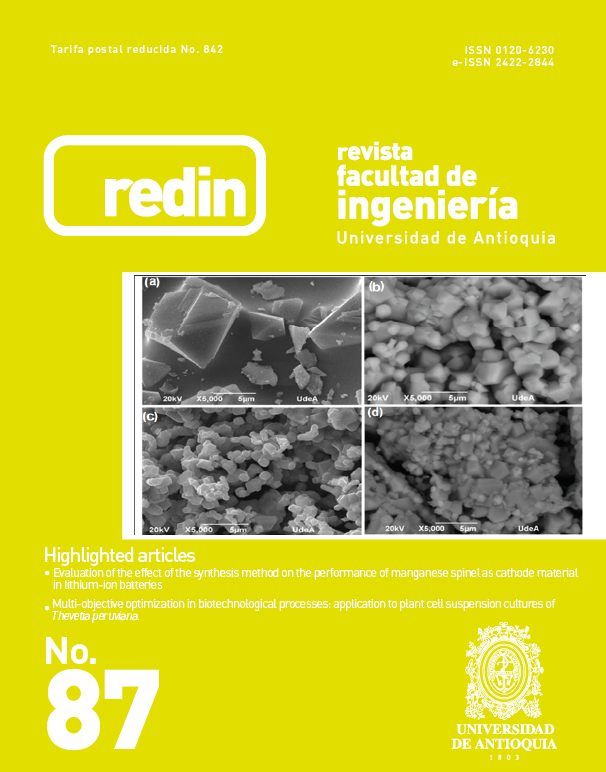Modelado y control de procesos usando el simulador EMSO y PLC SIMATIC como interfaz OPC
DOI:
https://doi.org/10.17533/udea.redin.n87a08Palabras clave:
simulador EMSO, control de procesos, herramientas educacionales, controladores PID y PBSMResumen
Este trabajo ilustra un procedimiento de modelado y control de procesos de nivel y flujo usando el simulador EMSO acoplado al proceso con un PLC SIMATIC S7-200 como interfaz de comunicación OPC entre la instrumentación del proceso y el sistema de cómputo del controlador. Para la supervisión de las variables del proceso se utilizó un modelo en SIMULINK conectado al proceso a través de comunicación OPC. El modelo obtenido fue utilizado en el diseño de controladores PID y PBSM, los cuales fueros probados ante saltos de set point y una trayectoria de set point impuesta.
Descargas
Citas
R. de Pelegrini, “Desenvolvimento de um simulador genérico de processos dinâmicos,” M.S. thesis, Universidade Federal do Rio Grande do Sul, Porto Alegre, Brazil, 2003.
R. de Pelegrini and A. R. Secchi, “Emso: A new environment for modelling, simulation and optimisation,” Comput. Chem. Eng., vol. 14, pp. 947–952, 2003.
R. de Pelegrini and A. R. Secchi, “Emso: An integrated tool for process modeling, dynamic simulation and optimization,” in Proceedings of the AIChE Annual Meeting, 2003, pp. 451–464.
T. corrêa, A. R. Secchi, and E. C. Biscaia, “A continuous implementation of the ideal time delay in EMSO simulator,” Comput. Aided Chem. Eng., vol. 27, pp. 273–278, 2009.
J. L. Díaz and H. D. Álvarez, “Una plataforma en EMSO® para modelar pérdidas por fricción en plantas de procesos,” Lámpsakos, pp. 79–91, Jul. 2014.
J. ospino, M. E. sánchez, and A. R. Secchi, “Implementation of a block-oriented model library for undergraduate process control courses in EMSO simulator,” Educ. Chem. Eng., vol. 18, pp. 45–57, Jan. 2017.
R. Rodrigues, R. de Pelegrini, and A. R. Secchi, “Teaching chemical reaction engineering using EMSO simulator,” Comput. Appl. Eng. Educ., vol. 18, no. 4, pp. 607–618, Dec. 2010.
“Dynamic simulation and optimization using EMSO,” Lecture Notes, A. R. Secchi, Brazil, Feb. 2012.
H. Alvarez, R. Lamanna, P. Vega, and S. Revollar, “Metodología para la obtención de modelos semifísicos de base fenomenológica aplicada a una sulfitadora de jugo de caña de azúcar,” Rev. Iberoam. Automática e Informática Ind., vol. 6, no. 3, pp. 10–20, Jul. 2009.
EMSO Manual, R. de Pelegrini, Brazil, 2007.
EMSO-OPC Link Manual, T. F. Finkler and R. de Pelegrini, Brazil, 2007.
Siemens Product Support. (2005, Jun. 14) ¿cómo se debe configurar el opc-server pc access para que el WinCC flexible runtime funcione como cliente opc? [Online]. Available: https:// sie.ag/2wvvS9d
A. O’Dwyer, Handbook of PI and PID Controller Tuning Rules, 3rd ed. London, England: Imperial College Press, 2009.
C. A. Smith and A. R. Corripio, Principles and practice of automatic process control, 3rd ed. New York, USA: John Wiley & Sons, 2006.
M. L. Luyben and W. L. Luyben, Essentials for Process Control. New York, USA: McGraw-Hill, 1997.
J. A. Romagnoli and A. Palazoglu, Introduction to Process Control. Florida, USA: CRC Press, 2006.
T. E. Marlin, Process Control: Designing processes and control systems for dynamic performance. New York, USA: McGraw-Hill, 2000.
Descargas
Publicado
Cómo citar
Número
Sección
Licencia
Derechos de autor 2018 Revista Facultad de Ingeniería Universidad de Antioquia

Esta obra está bajo una licencia internacional Creative Commons Atribución-NoComercial-CompartirIgual 4.0.
Los artículos disponibles en la Revista Facultad de Ingeniería, Universidad de Antioquia están bajo la licencia Creative Commons Attribution BY-NC-SA 4.0.
Eres libre de:
Compartir — copiar y redistribuir el material en cualquier medio o formato
Adaptar : remezclar, transformar y construir sobre el material.
Bajo los siguientes términos:
Reconocimiento : debe otorgar el crédito correspondiente , proporcionar un enlace a la licencia e indicar si se realizaron cambios . Puede hacerlo de cualquier manera razonable, pero no de ninguna manera que sugiera que el licenciante lo respalda a usted o su uso.
No comercial : no puede utilizar el material con fines comerciales .
Compartir igual : si remezcla, transforma o construye a partir del material, debe distribuir sus contribuciones bajo la misma licencia que el original.
El material publicado por la revista puede ser distribuido, copiado y exhibido por terceros si se dan los respectivos créditos a la revista, sin ningún costo. No se puede obtener ningún beneficio comercial y las obras derivadas tienen que estar bajo los mismos términos de licencia que el trabajo original.










 Twitter
Twitter